
Vertical intervals: lines, crossbars & errorbars
Source:R/geom-crossbar.R, R/geom-errorbar.R, R/geom-linerange.R, and 1 more
geom_linerange.RdVarious ways of representing a vertical interval defined by x,
ymin and ymax. Each case draws a single graphical object.
Usage
geom_crossbar(
mapping = NULL,
data = NULL,
stat = "identity",
position = "identity",
...,
middle.colour = NULL,
middle.color = NULL,
middle.linetype = NULL,
middle.linewidth = NULL,
box.colour = NULL,
box.color = NULL,
box.linetype = NULL,
box.linewidth = NULL,
fatten = deprecated(),
na.rm = FALSE,
orientation = NA,
show.legend = NA,
inherit.aes = TRUE
)
geom_errorbar(
mapping = NULL,
data = NULL,
stat = "identity",
position = "identity",
...,
orientation = NA,
lineend = "butt",
na.rm = FALSE,
show.legend = NA,
inherit.aes = TRUE
)
geom_errorbarh(..., orientation = "y")
geom_linerange(
mapping = NULL,
data = NULL,
stat = "identity",
position = "identity",
...,
orientation = NA,
lineend = "butt",
na.rm = FALSE,
show.legend = NA,
inherit.aes = TRUE
)
geom_pointrange(
mapping = NULL,
data = NULL,
stat = "identity",
position = "identity",
...,
orientation = NA,
fatten = deprecated(),
lineend = "butt",
na.rm = FALSE,
show.legend = NA,
inherit.aes = TRUE
)Arguments
- mapping
Set of aesthetic mappings created by
aes(). If specified andinherit.aes = TRUE(the default), it is combined with the default mapping at the top level of the plot. You must supplymappingif there is no plot mapping.- data
The data to be displayed in this layer. There are three options:
NULL(default): the data is inherited from the plot data as specified in the call toggplot().A
data.frame, or other object, will override the plot data. All objects will be fortified to produce a data frame. Seefortify()for which variables will be created.A
functionwill be called with a single argument, the plot data. The return value must be adata.frame, and will be used as the layer data. Afunctioncan be created from aformula(e.g.~ head(.x, 10)).
- stat
The statistical transformation to use on the data for this layer. When using a
geom_*()function to construct a layer, thestatargument can be used to override the default coupling between geoms and stats. Thestatargument accepts the following:A
Statggproto subclass, for exampleStatCount.A string naming the stat. To give the stat as a string, strip the function name of the
stat_prefix. For example, to usestat_count(), give the stat as"count".For more information and other ways to specify the stat, see the layer stat documentation.
- position
A position adjustment to use on the data for this layer. This can be used in various ways, including to prevent overplotting and improving the display. The
positionargument accepts the following:The result of calling a position function, such as
position_jitter(). This method allows for passing extra arguments to the position.A string naming the position adjustment. To give the position as a string, strip the function name of the
position_prefix. For example, to useposition_jitter(), give the position as"jitter".For more information and other ways to specify the position, see the layer position documentation.
- ...
Other arguments passed on to
layer()'sparamsargument. These arguments broadly fall into one of 4 categories below. Notably, further arguments to thepositionargument, or aesthetics that are required can not be passed through.... Unknown arguments that are not part of the 4 categories below are ignored.Static aesthetics that are not mapped to a scale, but are at a fixed value and apply to the layer as a whole. For example,
colour = "red"orlinewidth = 3. The geom's documentation has an Aesthetics section that lists the available options. The 'required' aesthetics cannot be passed on to theparams. Please note that while passing unmapped aesthetics as vectors is technically possible, the order and required length is not guaranteed to be parallel to the input data.When constructing a layer using a
stat_*()function, the...argument can be used to pass on parameters to thegeompart of the layer. An example of this isstat_density(geom = "area", outline.type = "both"). The geom's documentation lists which parameters it can accept.Inversely, when constructing a layer using a
geom_*()function, the...argument can be used to pass on parameters to thestatpart of the layer. An example of this isgeom_area(stat = "density", adjust = 0.5). The stat's documentation lists which parameters it can accept.The
key_glyphargument oflayer()may also be passed on through.... This can be one of the functions described as key glyphs, to change the display of the layer in the legend.
- middle.colour, middle.color, middle.linetype, middle.linewidth
Default aesthetics for the middle line. Set to
NULLto inherit from the data's aesthetics.- box.colour, box.color, box.linetype, box.linewidth
Default aesthetics for the boxes. Set to
NULLto inherit from the data's aesthetics.- fatten
A multiplicative factor used to increase the size of the middle bar in
geom_crossbar()and the middle point ingeom_pointrange().- na.rm
If
FALSE, the default, missing values are removed with a warning. IfTRUE, missing values are silently removed.- orientation
The orientation of the layer. The default (
NA) automatically determines the orientation from the aesthetic mapping. In the rare event that this fails it can be given explicitly by settingorientationto either"x"or"y". See the Orientation section for more detail.- show.legend
Logical. Should this layer be included in the legends?
NA, the default, includes if any aesthetics are mapped.FALSEnever includes, andTRUEalways includes. It can also be a named logical vector to finely select the aesthetics to display. To include legend keys for all levels, even when no data exists, useTRUE. IfNA, all levels are shown in legend, but unobserved levels are omitted.- inherit.aes
If
FALSE, overrides the default aesthetics, rather than combining with them. This is most useful for helper functions that define both data and aesthetics and shouldn't inherit behaviour from the default plot specification, e.g.annotation_borders().- lineend
Line end style, one of
"round","butt"or"square".
Orientation
This geom treats each axis differently and, thus, can have two
orientations. Often the orientation is easy to deduce from a combination of
the given mappings and the types of positional scales in use. Thus, ggplot2
will by default try to guess which orientation the layer should have. Under
rare circumstances, the orientation is ambiguous and guessing may fail. In
that case the orientation can be specified directly using the orientation
parameter, which can be either "x" or "y". The value gives the axis that
the geom should run along, "x" being the default orientation you would
expect for the geom.
See also
stat_summary() for examples of these guys in use,
geom_smooth() for continuous analogue
Aesthetics
geom_linerange() understands the following aesthetics. Required aesthetics are displayed in bold and defaults are displayed for optional aesthetics:
| • | x or y | |
| • | ymin or xmin | |
| • | ymax or xmax | |
| • | alpha | → NA |
| • | colour | → via theme() |
| • | group | → inferred |
| • | linetype | → via theme() |
| • | linewidth | → via theme() |
Note that geom_pointrange() also understands size for the size of the points.
Learn more about setting these aesthetics in vignette("ggplot2-specs").
Examples
# Create a simple example dataset
df <- data.frame(
trt = factor(c(1, 1, 2, 2)),
resp = c(1, 5, 3, 4),
group = factor(c(1, 2, 1, 2)),
upper = c(1.1, 5.3, 3.3, 4.2),
lower = c(0.8, 4.6, 2.4, 3.6)
)
p <- ggplot(df, aes(trt, resp, colour = group))
p + geom_linerange(aes(ymin = lower, ymax = upper))
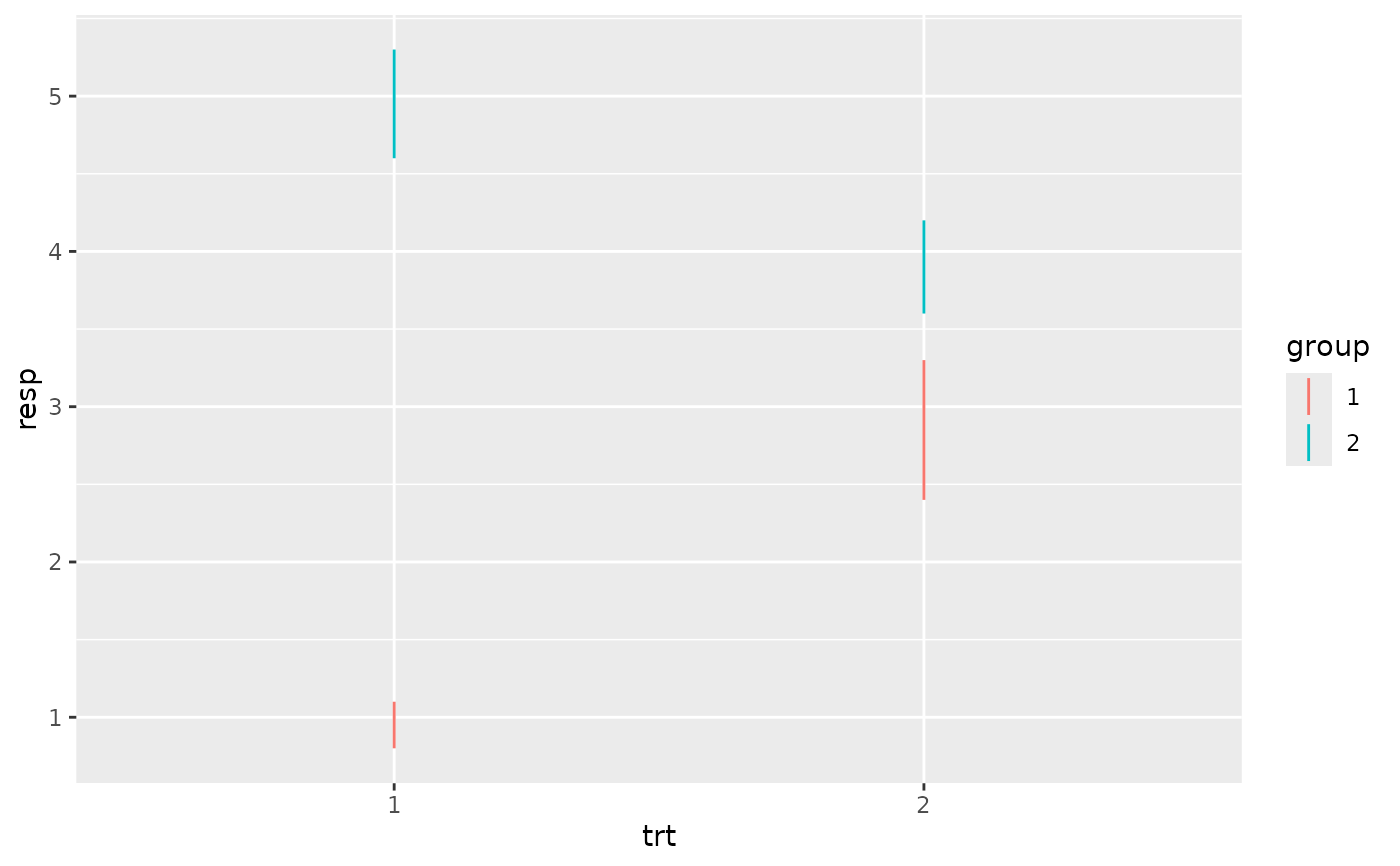 p + geom_pointrange(aes(ymin = lower, ymax = upper))
p + geom_pointrange(aes(ymin = lower, ymax = upper))
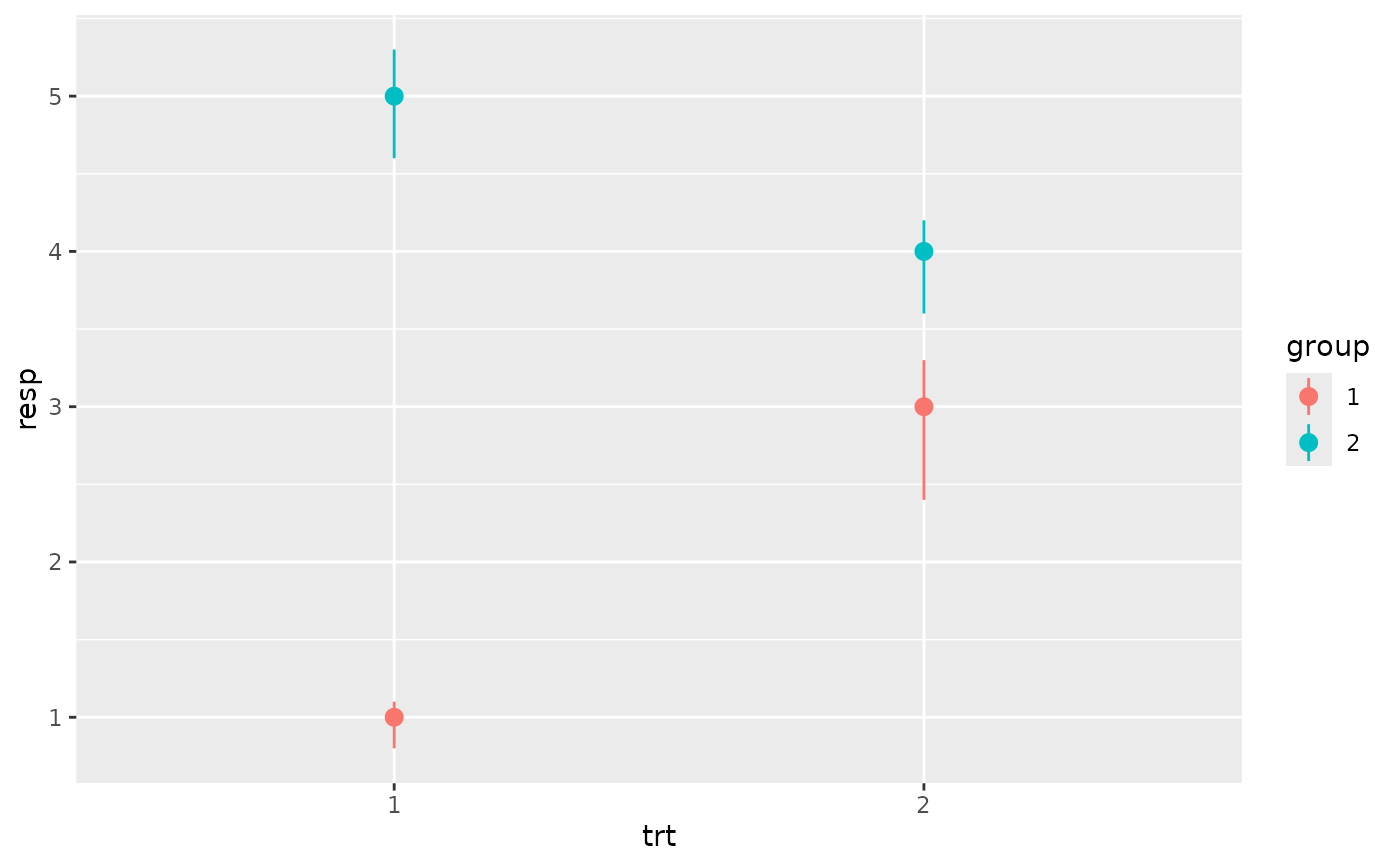 p + geom_crossbar(aes(ymin = lower, ymax = upper), width = 0.2)
p + geom_crossbar(aes(ymin = lower, ymax = upper), width = 0.2)
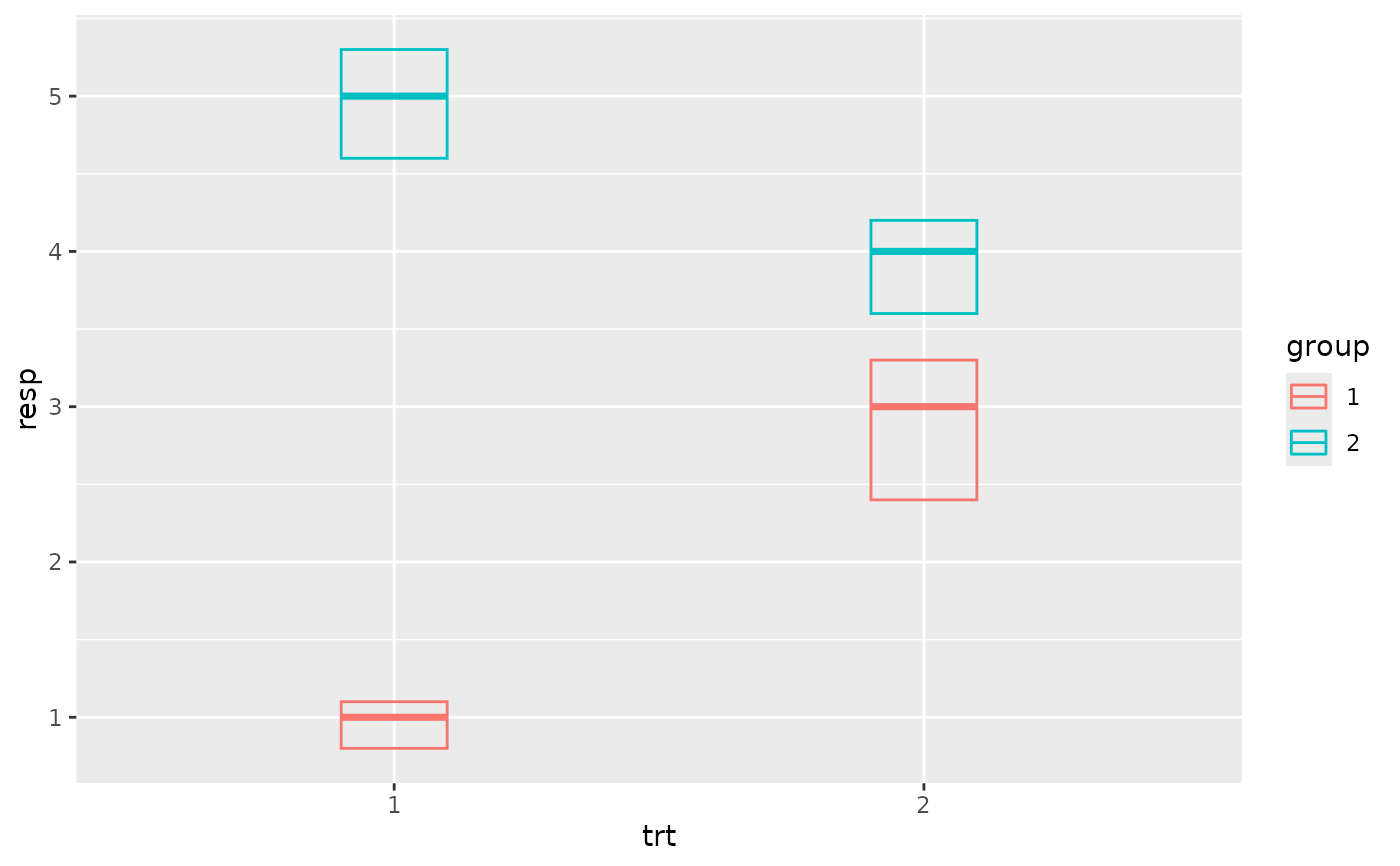 p + geom_errorbar(aes(ymin = lower, ymax = upper), width = 0.2)
p + geom_errorbar(aes(ymin = lower, ymax = upper), width = 0.2)
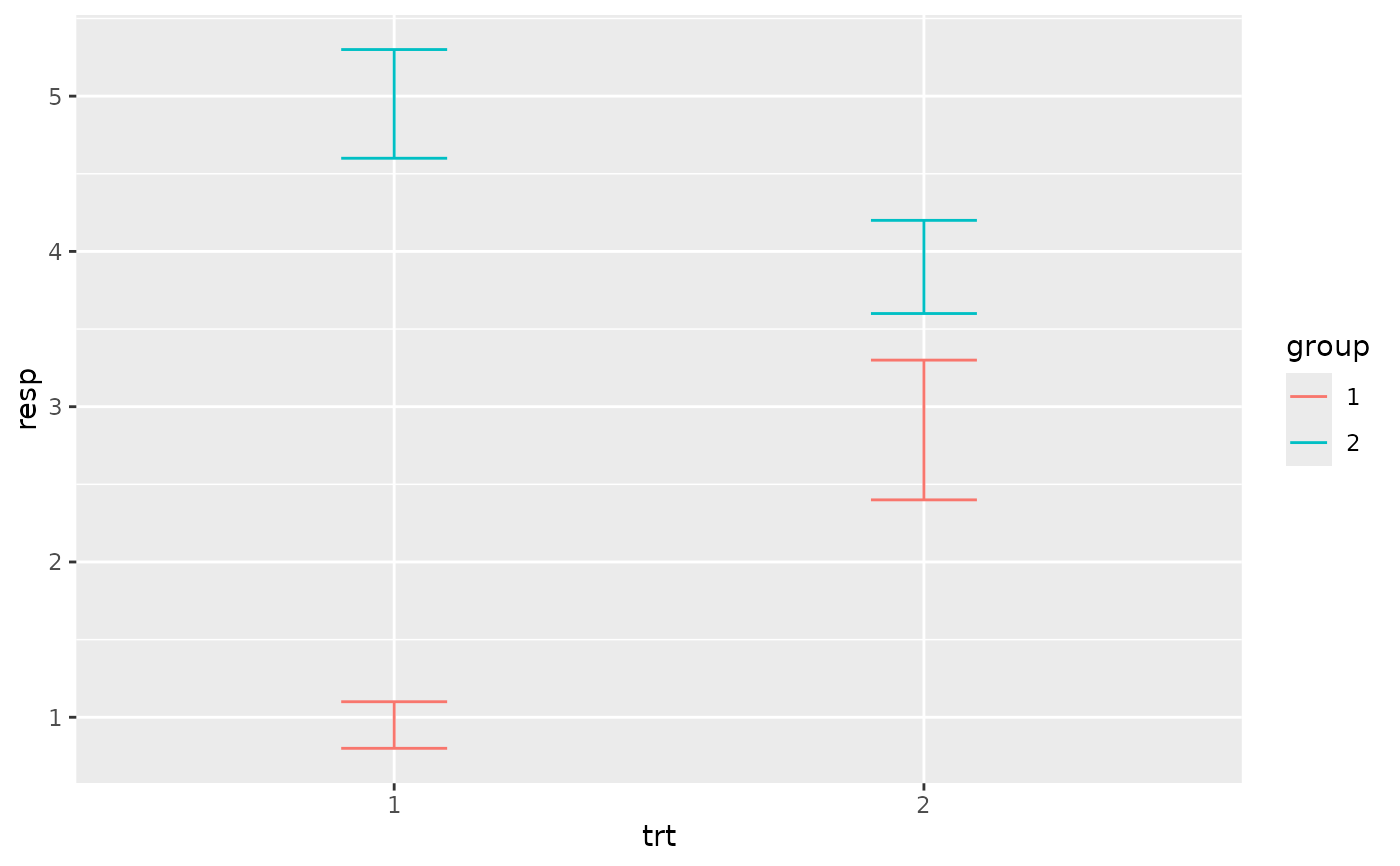 # Flip the orientation by changing mapping
ggplot(df, aes(resp, trt, colour = group)) +
geom_linerange(aes(xmin = lower, xmax = upper))
# Flip the orientation by changing mapping
ggplot(df, aes(resp, trt, colour = group)) +
geom_linerange(aes(xmin = lower, xmax = upper))
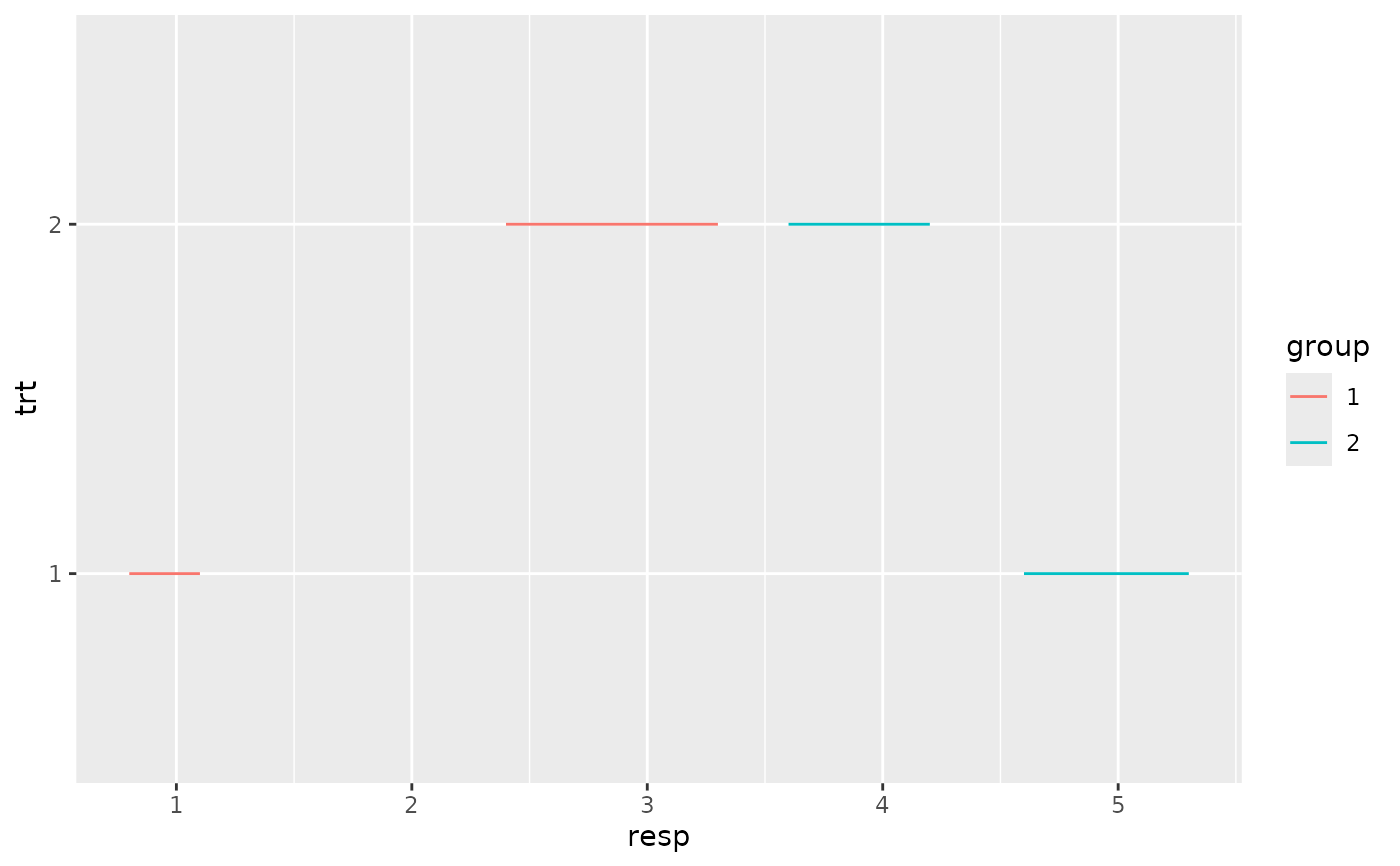 # Draw lines connecting group means
p +
geom_line(aes(group = group)) +
geom_errorbar(aes(ymin = lower, ymax = upper), width = 0.2)
# Draw lines connecting group means
p +
geom_line(aes(group = group)) +
geom_errorbar(aes(ymin = lower, ymax = upper), width = 0.2)
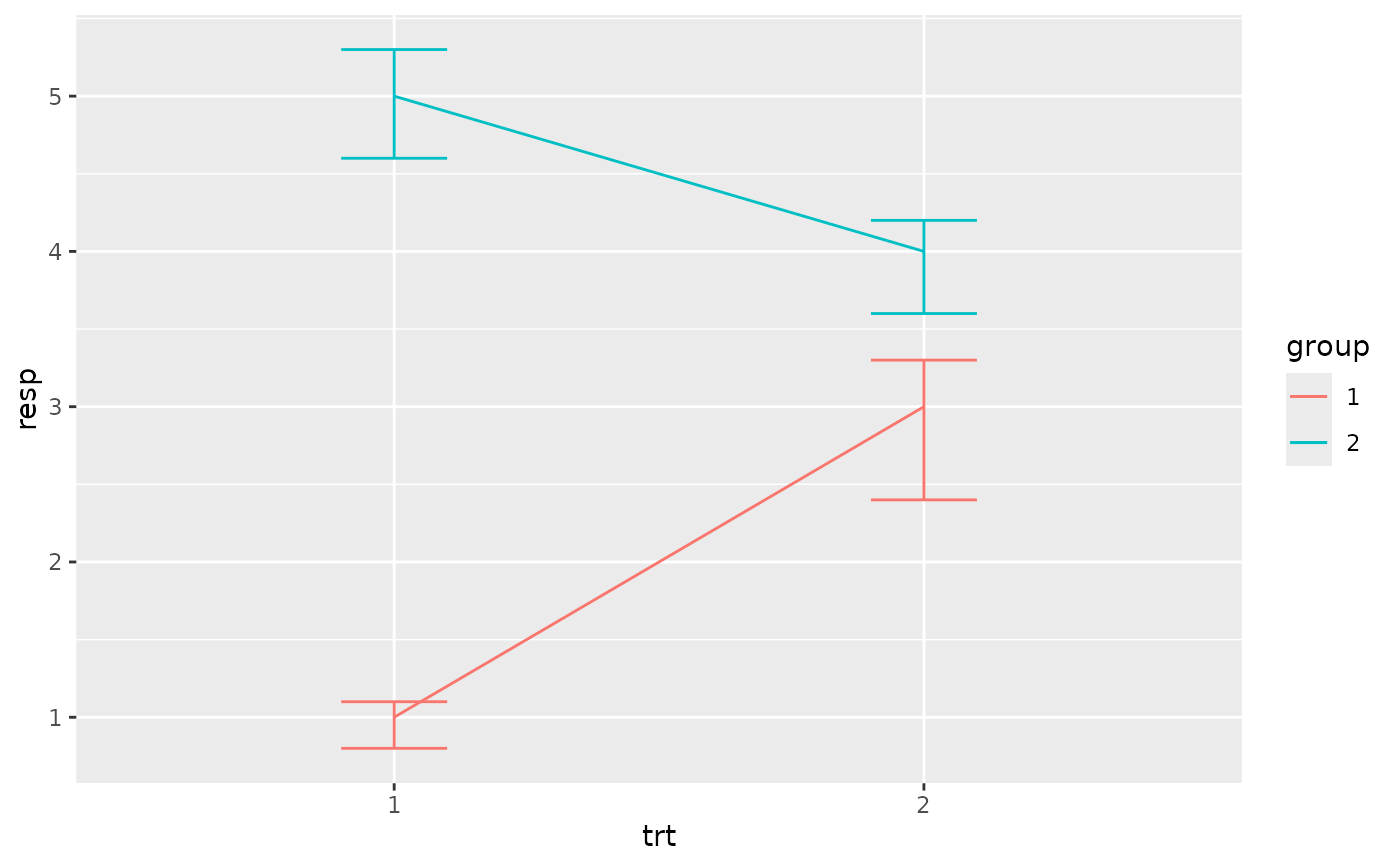 # If you want to dodge bars and errorbars, you need to manually
# specify the dodge width
p <- ggplot(df, aes(trt, resp, fill = group))
p +
geom_col(position = "dodge") +
geom_errorbar(aes(ymin = lower, ymax = upper), position = "dodge", width = 0.25)
# If you want to dodge bars and errorbars, you need to manually
# specify the dodge width
p <- ggplot(df, aes(trt, resp, fill = group))
p +
geom_col(position = "dodge") +
geom_errorbar(aes(ymin = lower, ymax = upper), position = "dodge", width = 0.25)
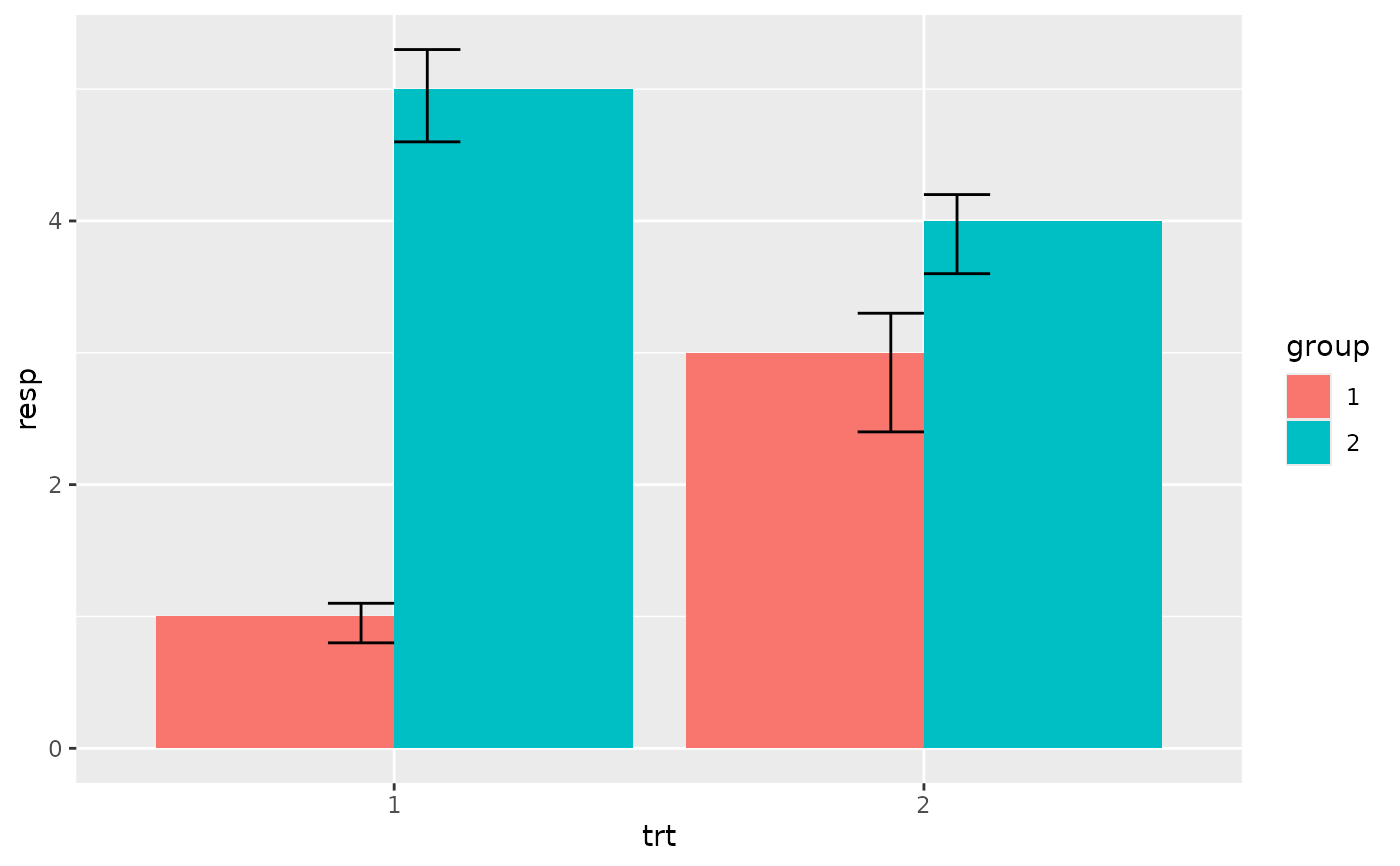 # Because the bars and errorbars have different widths
# we need to specify how wide the objects we are dodging are
dodge <- position_dodge(width=0.9)
p +
geom_col(position = dodge) +
geom_errorbar(aes(ymin = lower, ymax = upper), position = dodge, width = 0.25)
# Because the bars and errorbars have different widths
# we need to specify how wide the objects we are dodging are
dodge <- position_dodge(width=0.9)
p +
geom_col(position = dodge) +
geom_errorbar(aes(ymin = lower, ymax = upper), position = dodge, width = 0.25)
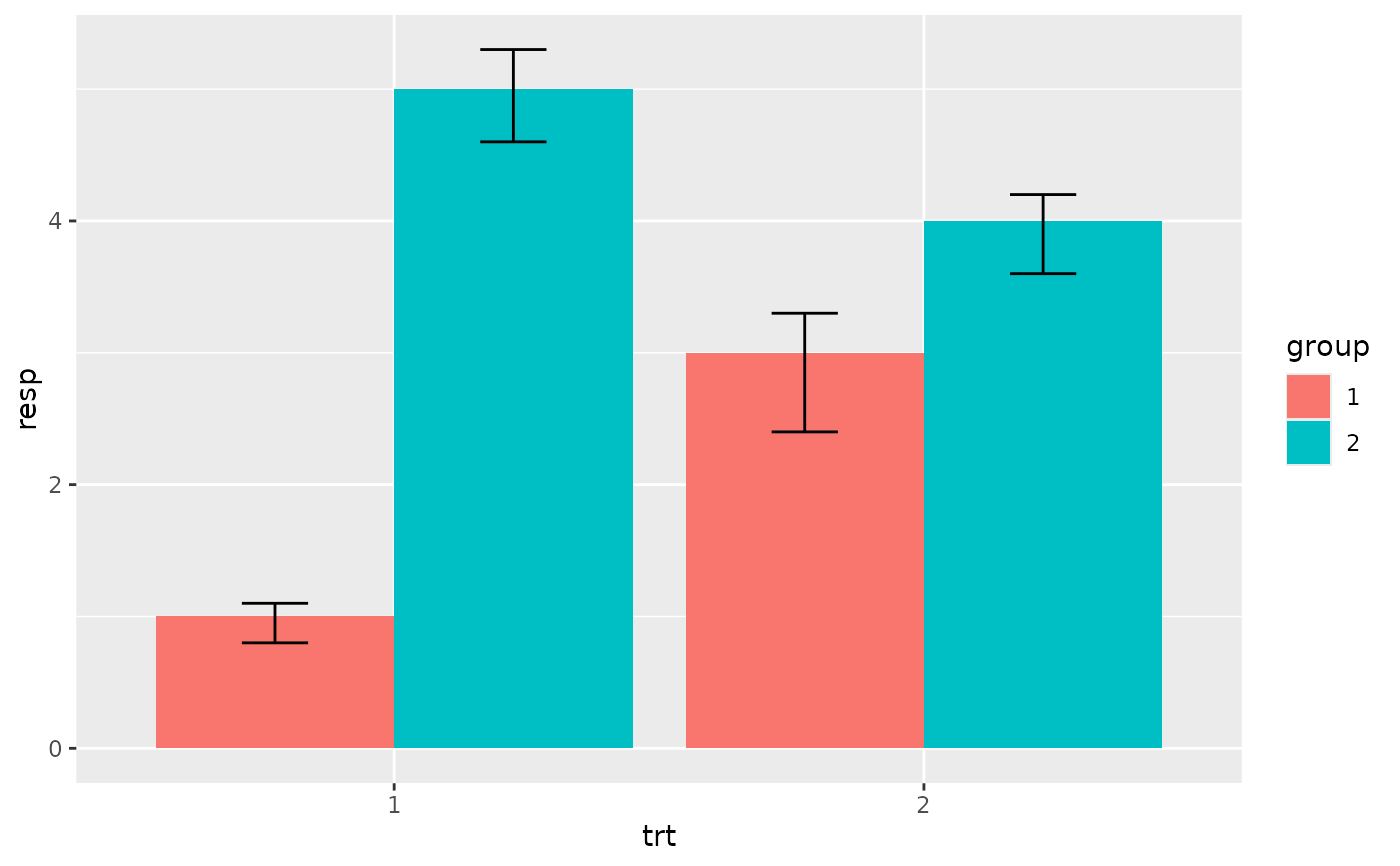 # When using geom_errorbar() with position_dodge2(), extra padding will be
# needed between the error bars to keep them aligned with the bars.
p +
geom_col(position = "dodge2") +
geom_errorbar(
aes(ymin = lower, ymax = upper),
position = position_dodge2(width = 0.5, padding = 0.5)
)
# When using geom_errorbar() with position_dodge2(), extra padding will be
# needed between the error bars to keep them aligned with the bars.
p +
geom_col(position = "dodge2") +
geom_errorbar(
aes(ymin = lower, ymax = upper),
position = position_dodge2(width = 0.5, padding = 0.5)
)
